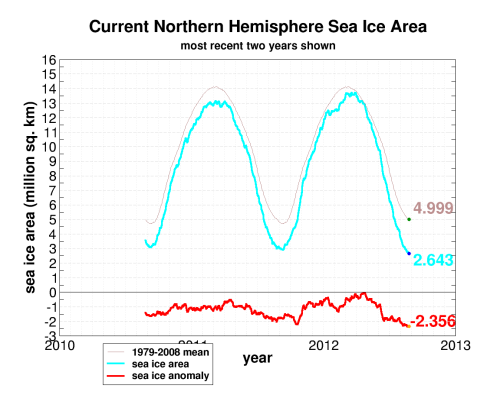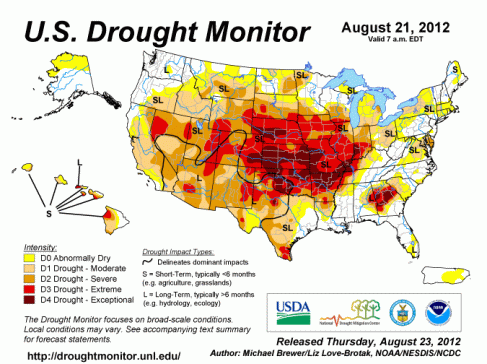
We are getting ourselves into a rather severe fix. Arctic sea ice is melting at a very rapid rate and changes are happening to the Arctic environment at a pace much faster than that expected by many scientists. These observable changes to the world’s climate were predicted. It is just the rate at which they are happening which is so startling.
The most conservative, early, predictions estimated sea ice would average around 8 million square kilometers by the end of the melt season in 2012. Even the later, more aggressive, models showed an average of about 5.5 million square kilometers by this year. In the record, according to the Japanese Space Agency (JAXA), we are currently sitting at less than 4 million square kilometers of sea ice — with more than two weeks still remaining in the melt season. This is twice the average melt predicted as near back as a year ago. And the current model predictions are still woefully behind.
This lagging of prediction behind the pace of change is a simple underestimation, by mainstream climate scientists, of how sensitive the Earth is to the force of human greenhouse gas emissions. It is also a broader failure of society to encourage scientists to do the work necessary to protect the long-term interests of our civilizations. Instead, we have allowed monied interests to engage in vicious, politically-driven attacks on the scientists who should be the watch-dogs against the harm caused by human global warming.
In short, based on current observations, the climate system in the Arctic appears to be extremely sensitive to the human greenhouse forcing. And, as such, it is rapidly changing, altering in ways that will further worsen the already serious impact of human-caused climate change.
This foreseen impact could have been prevented had we received a more immediate and widely trumpeted warning, had we gathered the political will to act, and had the monied interests not decided to wage a war on the future for a few temporary and transient gains. Instead, we are now injected into a world where constant change is becoming the norm. Instead, we must fend off powerful, entrenched interests in order to have an inkling of hope to prevent the worst impacts even as we expect strong impacts for some time to come.
Loss of Sea Ice Reflectivity
The first impact of drastically smaller sea ice coverage is a loss of reflectivity or albedo. The sun is almost always in the Arctic sky during the summer months. This 24-hour shine beams down on all surfaces of the Arctic. And the darker surface of water absorbs much more of that solar energy than the white, reflective surfaces of an ice sheet.
Research has found that water is, on average, five degrees Celsius hotter under open ocean than under the white, reflective covering of an ice sheet. As more and more areas open up, they absorb more and more of the sun’s energy creating a much hotter Arctic environment. And, currently, we have about half the ice cover we enjoyed during the 1980s.
Loss of Late Season Snow Cover
As the Arctic Ocean warms, more air is warmed above the waters. These hotter airs then blow over land, warming it as well. The result is that snow cover in the high Arctic is reduced. 2012 saw the lowest level of snow cover on record.
Snow produces an effect similar to that of Arctic sea ice. It reflects the sun’s rays resulting in much cooler temperatures in regions of high snow cover. It also keeps the ground beneath it much colder. And ground beneath snows in the Arctic tend to be methane-trapping permafrost.
Land without snow cover is also darker than snow. So areas where high snow melt occurs will heat faster, having higher than average temperatures and breaking down the permafrost layer beneath.
Changing Weather Patterns
Recent research has found that the change in wind patterns brought about by melting sea ice and a warmer Arctic drastically alter the Jet Stream. The result is a tendency of the Jet Stream to travel in larger waves from north to south. In addition to creating ‘blocking patterns’ in the mid latitudes, these elongated atmospheric waves dig deeper into the temperate zones, sometimes touching the tropics. And when they do they create a powerful transport mechanism for moving hot air into the Arctic. The result is an even greater degree of amplification in Arctic heating.

(Image credit: Geophysical Research Letters)
Permafrost Methane Release
All this new hot air swirling about in the Arctic drastically increases the rate of melting both in the sea ice and on land. Eventually, the heat sinks into the soil where it does work melting permafrost.
All around the Arctic circle we have seen the effects of melting permafrost. Structures have crumbled as the soil beneath becomes softer. Coastlines, once hard as stone, are now just mud and are eaten away by a freshly churning Arctic sea. Throughout the wild Arctic, permafrost melt lakes have formed and these lakes seep high volumes of methane.

(Image credit: Energy BC)
The added methane throughout the Arctic increases fire hazards. High concentrations of methane are very flammable and may combust due to a lightning strike or as a result of the spontaneous heating of a balmy day. And throughout the Arctic we have seen a drastic increase in the rate of fires. Just this year, Siberia saw massive blazes devour miles and miles of tundra and Arctic wilderness.

(Image credit: NASA)
A vast amount of carbon is stored in the Arctic permafrost as well as in the forests and tundras above. A National Snow and Ice Data Center study conducted in 2008 found that from 1400-1700 gigatons of carbon were locked in frozen soils worldwide and that much of these soils were in the Arctic. NSIDC estimates that warming could result in carbon releases from Arctic soil equal to 15-35 percent of human greenhouse gas emissions. In 2011, China emitted about 29% of the world’s greenhouse gasses. The human forcing in the Arctic could, in the case of frozen permafrost alone, add another China worth of greenhouse gasses emitted into the atmosphere every year.
Yet a large portion of this carbon emission would come from methane. And methane is a greenhouse gas 20 times more potent than CO2. So even if a third of this added emission were methane, it could easily double the human forcing.
Clathrate Methane Release
Sadly, the permafrost, soils, and forests in the Arctic aren’t the only source of methane in the region. Large deposits of a substance called clathrates or methane hydrates rest upon or just beneath the Arctic sea bed. The clathrates are essentially frozen formations of methane combined with water. They tend to be rather unstable and sensitive to heating. In an Arctic ocean that is increasingly ice-free during the summer months, the water column can warm by as much as five degrees Celsius. This extra heating has the potential to destabilize clathrate formations.
About 1400 gigatons of methane is stored in clathrates. This is roughly equal to the amount stored in permafrost worldwide. So this potential added forcing combines with methane and carbon releases from the Arctic tundra.
Evidence of Amplifying Methane Release
Over the past four years, researchers have found a wealth of evidence pointing toward an amplified methane release in the Arctic. Atmospheric methane levels are on the rise.

(Image credit: NOAA)
A proliferating number of methane emitting ponds have been found throughout the Arctic. Large areas of ocean, especially in the East Siberian Sea, are emitting high volumes of methane. Underwater plumes of methane as large as one kilometer across have been discovered. And recent satellite research conducted by the University of Maryland shows that the amount of methane released from the Arctic is amplifying year-on-year.
The Next Domino to Fall: Greenland
The Arctic amplification described above is likely to have another non-linear affect — increasing direct impacts to Greenland ice melt. Loss of sea ice substantially reduces a buffer surrounding Greenland. In the past, sea ice served to block the flow of warm air masses and to protect Greenland from pulses of heat coming from the south. This was clearly not the case this summer when a very warm air mass repeatedly formed over Greenland, drastically increasing melt there.

(Image credit: NOAA)
Blocking patterns also have a tendency to park over Greenland, consistently funneling in warmer air from the south. Loss of permafrost and snow cover along with increased atmospheric methane create a witch’s brew of heat that could all result in a state-change in Greenland.
It is important to consider that loss of sea ice, though an important and devastating loss, results in relatively moderate impacts to human society when compared with Greenland ice loss. Imagine, for a moment, the loss of fifty percent of Greenland ice in a few decades. The result would be an 11 foot sea level rise. Now there are no scientific models or observations saying this will happen. But there were no models that estimated sea ice loss would be this rapid either. And though the mile-high glaciers of Greenland aren’t as likely to suffer from the same widely varied set of forces affecting sea ice, they are certainly not impenetrable. The issue here is that the risk to Greenland is high and the impacts, should the worst risks bear out, are very high.
It is worth re-emphasizing that after sea ice, should human greenhouse gas emissions not be vastly curtailed, Greenland will be the next domino to fall. And when it does, it will be almost impossible for the world to ignore.
Arctic Cooling Cycle Changing to Arctic Heating Cycle
The net effect of all these changes: Arctic sea ice melt, permafrost melt, methane release, and Greenland melt is that the cooling mechanism of the Arctic is being transformed into a warming mechanism. As we added greenhouse gasses to the atmosphere we relied on these cooling mechanisms to help maintain a stable climate and to prevent the worst impacts of human greenhouse gas heating. Now, these mechanisms have been forced by human climate change to a new a phase. A phase where they increasingly add to the problem, resulting in a powerful amplifying feedback, that will be more and more difficult to reign in should we continue to fail to respond.












































